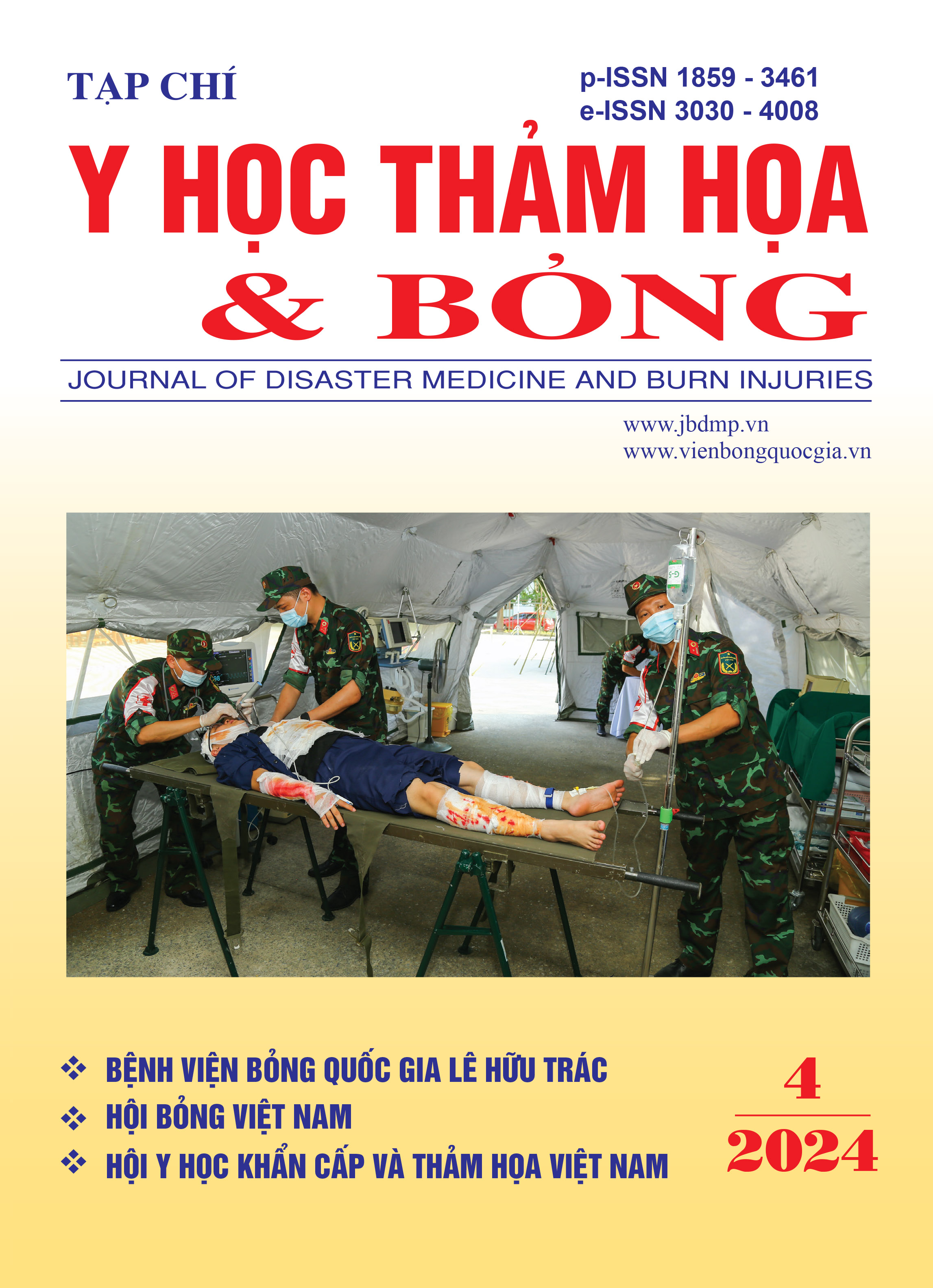So sánh chất lượng hồi tỉnh sau gây mê bằng Propofol và Sevoflurane cho phẩu thuật thẩm mĩ
Nội dung chính của bài viết
Tóm tắt
Mục tiêu: So sánh chất lượng hồi tỉnh giữa hai nhóm bệnh nhân (BN) được gây mê bằng Propofol hoặc Sevoflurane cho phẫu thuật thẩm mĩ.
Phương pháp: Nghiên cứu tiến cứu, can thiệp lâm sàng, phân nhóm ngẫu nhiên có so sánh trên 60 bệnh nhân chia thành 2 nhóm P (n = 30) được gây mê bằng Propofol và nhóm S (n = 30) được gây mê bằng Sevoflurane. Đánh giá các mốc thời gian giai đoạn hồi tỉnh, các tác dụng không mong muốn sau mổ, so sánh chất lượng hồi tỉnh bằng thang điểm QoR-40.
Kết quả: Thời gian tỉnh trở lại, thời gian tỉnh hoàn toàn, thời gian rút nội khí quản hoặc mask thanh quản, tỷ lệ nôn, buồn nôn ở các bệnh nhân nhóm P thấp hơn so với nhóm S (p < 0,05); điểm chất lượng hồi tỉnh theo QoR-40 nhóm P cao hơn nhóm S có ý nghĩa thống kê (p < 0,05).
Kết luận: Chất lượng hồi tỉnh sau gây mê bằng Propofol cho phẫu thuật thẩm mĩ tốt hơn so với gây mê bằng Sevoflurane.
Chi tiết bài viết
Từ khóa
Chất lượng hồi tỉnh, propofol, sevoflurane, phẫu thuật thẩm mĩ
Tài liệu tham khảo
2. Kumar G, Stendall C, Mistry R, Gurusamy K, Walker D. A comparison of total intravenous anesthesia using propofol with sevoflurane or desflurane in ambulatory surgery: systematic review and meta-analysis. Anesthesia. 2014; 69(10):1138-50.
3. Hofer CK, Zollinger A, Buchi S, Klaghofer R, Serafino D, Buhlmann S, et al. Patient well-being after general anesthesia: a prospective, randomized, controlled multi-centre trial comparing intravenous and inhalation anesthesia. Br J Anaesth. 2003;91(5):631-7.
4. Fassoulaki A, Melemeni A, Paraskeva A, Siafaka I, Sarantopoulos C. Postoperative pain and analgesic requirements after anesthesia with sevoflurane, desflurane or propofol. Anesth Analg. 2008;107(5):1715-9.
5. Li M, Mei W, Wang P, Yu Y, Qian W, Zhang ZG, et al. Propofol reduces early post-operative pain after gynecological laparoscopy. Acta Anaesthesiol Scand. 2012;56(3):368-75.
6. Fredman B, Nathanson MH, Smith I, Wang J, Klein K, White P. Sevoflurane for outpatient anesthesia: a comparison with Propofol. Anesth Analg. 1995; 81(4):823-8.
7. Brioni JD, Varughese S, Ahmed R, Bein B. A clinical review of inhalation anesthesia with sevoflurane: from early research to emerging topics. J Anesth. 2017;31(5):764-78.
8. Nguyễn Thị Diệu Linh, Hoàng Văn Bách, Công Quyết Thắng. So sánh hiệu quả gây mê theo nồng độ đích của Et Control- Sevoflurane với TCI - Propofol dưới chỉ dẫn của điện não hóa số. Tạp chí Y học Việt Nam. 530, 1B (tháng 9 2023). DOI:https://doi.org/10.51298/vmj.v530i1B.6716.
9. Myles PS, Weitkamp B, Jones K, et al. Validity and reliability of a postoperative quality of recovery score: the QoR-40. British Journal of Anaesthesia 84 (1): 11–15 (2000).
10. Hofer CK, Zollinger A, Buchi S, Klaghofer R, Serafino D, Buhlmann S, et al. Patient well-being after general anesthesia: a prospective, randomized, controlled multi-centre trial comparing intravenous and inhalation anesthesia. Br J Anaesth. 2003;91(5):631-7.
11. Vasileiou I, Xanthos T, Koudouna E, Perrea D, Klonaris C, Katsargyris A, et al. Propofol: a review of its non-anaesthetic effects. Eur J Pharmacol. 2009; 605(1-3):1-8.
12. Li KY, Xiao C, Xiong M, Delphin E, Ye JH. Nanomolar propofol stimulates glutamate transmission to dopamine neurons: a possible mechanism of abuse potential? J Pharmacol Exp Ther. 2008;325(1):165–74.
13. Yoo YC, Bai SJ, Lee KY, Shin S, Choi EK, Lee JW. Total intravenous anesthesia with propofol reduces postoperative nausea and vomiting in patients undergoing robot-assisted laparoscopic radical prostatectomy: a prospective randomized trial. Yonsei Med J. 2012; 53(6):1197-202.
14. Barann M, Göthert M, Fink K, Bönisch H. Inhibition by anaesthetics of 14 Cguanidinium flux through the voltage-gated sodium channel and the cation channel of the 5-HT 3 receptor of N1E-115 neuroblastoma cells. Naunyn Schmiedeberg's Arch Pharmacol. 1993;347(2):125-32.
15. Gilliland HE, Armstrong MA, Carabine U, McMurray TJ. The choice of anesthetic maintenance technique influences the antiinflammatory cytokine response to abdominal surgery. Anesth Analg. 1997;85(6):1394-8.
16. Crippa J, Mari GM, Miranda A, Costanzi AT, Maggioni D. Surgical stress response and enhanced recovery after laparoscopic surgery - a systematic review. Chirurgia (Bucur). 2018;113(4):455-63.
17. Ledowski T, Paech MJ, Patel B, Schug SA. Bronchial mucus transport velocity in patients receiving propofol and remifentanil versus sevoflurane and remifentanil anesthesia. Anesth Analg. 2006;102(5):1427-30.


